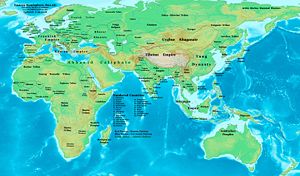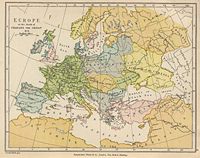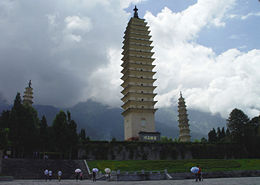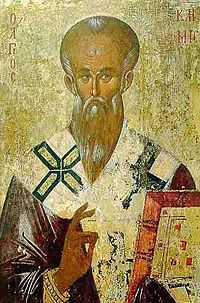9th century
2008/9 Schools Wikipedia Selection. Related subjects: General history
| Millennium: | 1st millennium |
|---|---|
| Centuries: | 8th century · 9th century · 10th century |
| Decades: | 800s 810s 820s 830s 840s 850s 860s 870s 880s 890s |
| Categories: | Births – Deaths Establishments – Disestablishments |
The 9th century is the period from 801 to 900 in accordance with the Julian calendar in the Christian Era.
Western European

Art of the "Dark Ages"
First and foremost, art existed because the Church required it. The basic tools of the Roman Catholic mass, thousands of golden art objects were made. Sacred cups, vessels, reliqueries, crucifixes, rosaries, altar pieces, and statues of the Virgin and Child or Saints all kept the flame of art from dying out in the period. Architecture began to revive to some extent by the 9th century. It took the form of Church facilities of all kinds, and the first castle fortifications since Roman times began to take form in simple "moat and baily" castles, or simple "strong point" tower structures, with little refinement.
Worldwide Events
- The Arab merchant Shulama wrote that Chinese junk ships could carry 600 to 700
passengers aboard for sailing missions into the Indian Ocean. He wrote that the draft of Chinese ships was too deep for entering the Euphrates River (modern-day Iraq), which forced them to land small boats on the banks of the river for passengers and cargo instead.
- An unknown event causes the decline of the Maya Classical Era.
- Beowulf might have been written down in this century, though it could also have been in the 8th century.
- Reign of Charlemagne, and concurrent (and controversially labeled) Carolingian Renaissance in Western Europe.
- Large-scale Viking attacks on Europe begin, devastating countless numbers of people.
- Oseberg ship burial.
- The Magyars arrive in what is now Hungary, taking it from Bulgaria.
- The Tukolor settle in the Senegal river valley.
- Muslim traders settle in the northwest and southeast of Madagascar.
- 800 — Arab fleet sails up the Tiber.
- 803 — Construction on the Leshan Giant Buddha in Tang Dynasty China is complete, after 90 years of rock-carving on a massive cliff-side.
- C. 813–c. 915 — period of serious Arab naval raids on shores of Tyrrhenian and Adriatic seas.
- 830 - House of Wisdom, a library and translation institute, established by al-Ma'mun, Abbasid caliph, in Baghdad to transfer the knowledge of Greeks, Persians, Indians, etc to Muslim world. Also The Compendious Book on Calculation by Completion and Balancing which is one of the book of algebra is written by Al-Khwarizmi who worked there.
- 848– 852 — The west bank of the Tiber is annexed into the city of Rome. A defensive wall, commissioned by Pope Leo IV, is built around what came to be called the Leonine City.
- 851 — The Arab merchant Suleiman al-Tajir visits the Chinese seaport at Guangzhou in southern China, and observes the manufacturing of porcelain, the Islamic mosque built at Guangzhou, the granary system of the city, and how its municipal administration functioned.
- 863 — The Chinese author Duan Chengshi describes the slave trade, ivory trade, and ambergris trade of Somalia in East Africa.
- 870 — Prague Castle founded.
- 800– 909 — rule of Aghlabids as an independent Muslim dynasty in North Africa.
- 850– 875 — The first Norse settlers arrive on Iceland.
- 859 Muslim established the oldest university in the world, University of Al Karaouine, in Fez, Morocco
- 863– 879 — period of schism between eastern and western churches.
- 864 — Christianization of Bulgaria under Boris I
- 875– 884 — Huang Chao leads an unsuccessful rebellion against the Tang Dynasty in China.
- Late 9th century: Bulgaria stretches from the mouth of the Danube to Epirus and Bosnia.
- In Italy, some cities became free republics: for instance Forlì, in the 889.
- The Christian Nubian kingdom reaches its peak of prosperity and military power. ( Early history of Sudan).
- Harald Fairhair was victorious at the battle of Hafrsfjord, and Norway was unified into one kingdom.
- Chess reaches Japan.
- 862 — The beginning the Rurik Dynasty in Russia
- 885 — arrival of the disciples of SS. Cyril and Methodius, Clement of Ohrid and Naum of Preslav in Bulgaria. Development of the Cyrillic Alphabet.
- 867 — onward Revival of the Byzantine Empire under the Macedonian dynasty.
- The Medieval Warm Period begins.
Significant people
- Adi Sankara
- Al-Jahiz
- Alfred the Great
- Arnulf of Carinthia
- Basil I the Macedonian (Βασίλειος Α') ( 811– 886), ruled ( 867)–( 886)
- Boris I of Bulgaria
- Charlemagne
- Clement of Ohrid
- Han Yu
- Harald I of Norway
- Huang Chao
- Kenneth I of Scotland
- Louis the Pious
- Naum of Preslav
- Rurik
- Saint Cyril and Saint Methodius
- Taizu of Later Liang
- Wang Kon
Inventions, discoveries, introductions
- First image of a rotary grindstone in a European source — illustration shows crank, first known use of a crank in the West ( Utrecht Psalter, A.D. 843)
- First known printed book, the Diamond Sutra, printed in China using woodblock printing in 868 AD.
- Invention of gunpowder by Chinese Taoist Alchemists
- Vulgar Latin begins to devolve into various Romance languages
Decades and years
|
|||||||||||||||||||||||||||||||||||||||||||||||||||||||||||||||||||||||||||||||||||||||||||||||||||||||||||||||||||||||||||||||||||||||||
|
|||||||||||||||||||||||||||||||||||||||||||||||||||||||||||||||||||||||||||||||||||||||||||||||||||||||||||||||||||||





